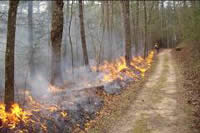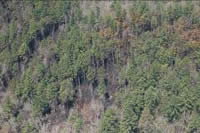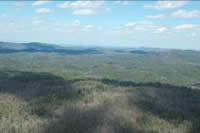
National Fire Plan Success Story
Hazardous Fuel Reduction Project Meets Both Fuels and Ecological Objectives
Great Smoky Mountains National Park, Tennessee
National Fire Plan - Fuels Reduction

Hand ignition of control line on the Arbutus Ridge Prescribed Fire. NPS photo by Travis Neppl, NPS Great Smoky Mountains Fire Use Module.

Aerial view of burn severity mosaic on Stony Ridge. NPS photo by David Loveland, NPS Great Smoky Mountains Fire Use Module.

Landscape mosaic as a result of pyrodiversity, Stony and Arbutus Ridge Prescribed Fires. NPS photo by David Loveland, NPS Great Smoky Mountains Fire Use Module.
Fire Management staff at Great Smoky Mountains National Park recently implemented a planned hazardous fuel reduction project in the heavily visited Cades Cove area of the park. The primary objective of this burn was to reduce the accumulation of hazardous fuels from the Stony and Arbutus creek drainages. Numerous significant cultural sites and popular trails adjoin or were encompassed by the burn units. These cultural values were at threat from wildfire due to the accumulation of forest fuels.
A secondary objective for this prescribed fire was to provide a second entry fire into the drainages in an effort to reduce the hardwood crowding of pine stands. The area has seen a general absence of fire and fire susceptible hardwoods have been succeeding the more fire tolerant pines. In order to achieve these different objectives, fire managers embraced the concept of pyro-diversity. Ignition crews took advantage of the varied topography to set a variety of fire types ranging from slow moving backing fires to moderate flanking fires and fast moving, intense head fires. This pyro-diversity resulted in a mosaic of fire effects within the burn unit and should lead to a healthy, biologically diverse forest stand. In all, over 1500 acres were burned over a six hour period.
Fire effects monitors are currently evaluating numerous permanent monitoring plots to assess the effectiveness to the prescribed fire. The plots will be revisited on a recurring basis to track species composition and relative abundance over time. Managers plan on implementing further fuel reduction burns in and around Cades Cove as conditions permit.
Contact: David Loveland, Great Smoky Mountains Fire Use Module
Phone: (865) 436-1711